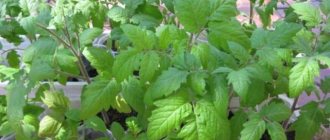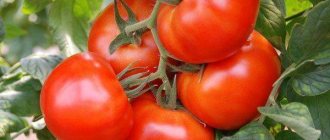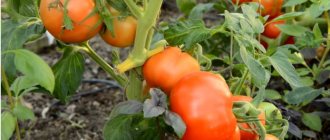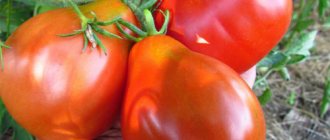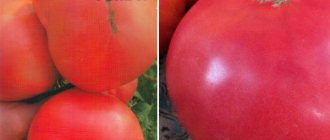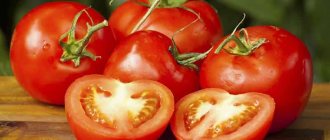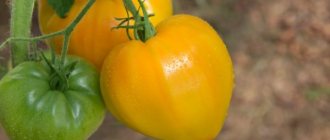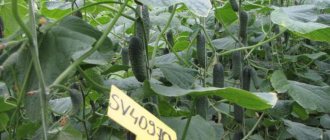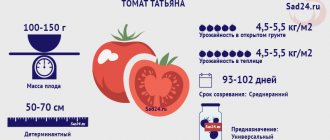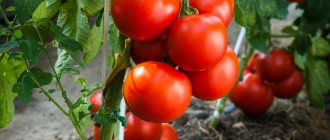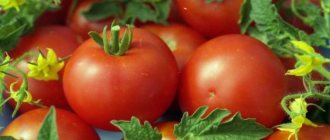Summer Garden is an early-ripening hybrid of tomatoes for planting in a greenhouse or open ground. Tomatoes contain many useful substances, and their taste pleasantly pleases many gourmets. Before planting this variety, carefully read its characteristics.
Tomato seeds Summer Garden
Summer Garden tomatoes are round, smooth, fleshy and with a lot of seeds
From one square meter you can harvest up to 17 kg of tomatoes
Characteristic
This versatile variety is one of the early hybrids. For planting, use seeds or seedlings, open ground or greenhouse conditions. The fruits ripen throughout the growing season and maintain a presentable appearance during storage and transportation.
Other features of the Summer Garden variety:
- yield - up to 17 kg of fruits from 1 square area;
- ovary maturation – carpal;
- bush height – up to 60 cm;
- number of brushes – 3-4 on each bush;
- ripeness - 90-100 days after planting the seeds.
Fruit
The tomatoes are round, symmetrical, deep red in color with smooth skin. The ripe fruit weighs 120-150 g, grows in clusters of 5-8 pieces. The flesh is dense and elastic, but meaty. The fruits are multi-chambered, so they contain a lot of seeds.
When technically ripe, the tomatoes are pale, without a green spot at the stalk. When biologically ripe, tomatoes acquire a deep red or orange color, dense consistency and fleshy pulp. The Summer Garden variety is used fresh or goes for processing.
Productivity
In addition to frost resistance, an important selection criterion for vegetable growers is the high yield of the variety. During the fruiting period, you can harvest up to 3-4 kg of ripe tomatoes from one bush. From 1 square of area - up to 17 kg of tomatoes. The fruits ripen in clusters, which simplifies harvesting.
General description of the hybrid Summer Garden
Summer Garden is a first generation tomato hybrid. This is indicated by the f1 mark in the title. The tomato was developed by crossing two other varieties.
Important ! Seeds from the hybrid tomato crop are not suitable for planting. In 98% of cases, the plants grown from them acquire the characteristics of one of the crossed varieties.
Summer Garden f1 was included in the Russian register in 2001. Although the hybrid has appeared on horticultural markets for quite some time, its popularity has not diminished.
Distinctive features of the variety
The Summer Garden tomato is characterized by early ripening. Its berries ripen at the end of June or beginning of July. These are the tomatoes that first appear on gardeners' tables.
The appearance of the fruits does not stand out in any way. Summer Garden berries are round in shape, medium in size and orange-red in color.
The taste is normal tomato. Despite their early ripening, these tomatoes are not tasteless, their aroma is rich. The pulp is dense and juicy.
The tomato hybrid is characterized by high yield. From 1 sq. m, more than 15 kg of fruits are collected. These are very high figures for early ripening tomatoes.
Low-growing bushes in the Summer Garden do not require staking or pinching. This feature makes growing tomatoes much easier.
This hybrid is also pleased with its immunity. It is resistant to most tomato diseases and is not afraid of late blight.
Main characteristics
Description of the hybrid Summer Garden will appeal to even novice gardeners.
| Parameter | Indicators |
| Bush type | Determinate low-growing hybrid. Not standard. The height of the bush reaches 40–50 cm. The plants are covered with an average amount of foliage. The leaves are simple, rich green, medium in size. The first simple inflorescence is formed in the axil of the 6th or 7th leaf. The next ones every 1-2 sheets. The fruits are produced in clusters. 6–8 berries are formed on one brush. |
| Growing method | In the southern and central regions it is grown in open ground. In the northern part of the country it is cultivated in greenhouses. |
| Productivity | High. One bush produces up to 4.5 kg of berries. From 1 sq. m harvest with a total weight of up to 17 kg. |
| Fruit | They have a medium size. The weight of one berry varies between 80–140 g. The shape is round and level. There is often faint ribbing at the base. The color is red-orange inside and out. Inside, there may be a lighter spot at the base. When unripe, tomatoes are almost white. The tomatoes taste sweet and sour with a rich aroma. The fruits are fleshy, the skin is smooth and shiny. The pulp is dense but juicy. There are many chambers in the fruit (up to 8). They contain seeds that are not suitable for planting. |
| Transportability | High. Tomatoes can be stored for up to a month and do not lose their presentation during transportation. |
| Ripening time | Early ripening tomato. Its fruits ripen 90–100 days after sowing the seeds. Fruiting continues until the end of August. |
| Disease resistance | It is resistant to tomato diseases, including late blight. |
Advantages and disadvantages of the Summer Garden
Above are some of the advantages of this tomato variety, but before purchasing Summer Garden seeds or seedlings, it is advisable to familiarize yourself with the full list:
- early ripeness of the fetus;
- high productivity;
- frost resistance;
- good taste of fruits;
- long shelf life;
- safety of fruits during transportation;
- stable immunity;
- no need for pinching or tying up bushes;
- versatility of fruit use.
These hybrids have their drawbacks, but they remain in the minority:
- stem cracks;
- excess seeds;
- pulp of dense consistency.
Features of cultivation
To get a good harvest, plant the seeds 60 days before transferring the young plant to open ground. The first ovaries appear 30 days after sowing; after another 30 days, ripened fruits can be collected. Be especially responsible when purchasing planting material.
Selection of seedlings
Buy seeds from trusted manufacturers, check each grain for integrity. If you plan to plant tomatoes from seedlings, consider the following criteria for choosing young seedlings:
- presence of 6-8 leaves;
- age of sprouts – 45-60 days;
- stem thickness – 5 mm;
- healthy, whole leaves are medium green in color.
The yield indicator depends not only on the seedlings, but also on proper care for them. For example, seedlings do not like the scorching rays of the sun, and in cold soil the root system only freezes.
Soil and fertilizers
For planting, choose fertile soil with neutral acidity. Pre-fluff the soil so that it receives more oxygen and is warmed by the sun's rays. Additionally, feed it with mineral and organic compounds.
A good composition for seedlings is a mixture of humus (1 part), peat (2 parts), garden soil (1 part) and sand (0.5 parts).
Before planting, sterilize the soil using one of the suggested methods:
- Calcination in the oven . Distribute a layer of soil 8-10 cm on a baking sheet, keep in the oven for 30 minutes at 200 degrees.
- Watering with hot water . Pour boiling water over the soil. When it cools down and dries slightly, use it to plant seedlings.
- Freezing. In winter, take the soil out onto the balcony for 3 days - 3 months. In warm climates, freeze the soil in the refrigerator.
- Treatment with a weak solution of potassium permanganate . The solution should turn out pale pink. Water the soil and then wait until it dries.
For intensive soil nutrition, use ready-made complexes, superphosphates, potassium fertilizer or urea. Treat acidic soil with slaked lime or wood ash to lower the pH of the environment.
An unusual aromatic variety masquerading as peppers - the Auria tomato: the secrets of a high yield
Those who like to experiment with growing unusual varieties of vegetable crops will not ignore the Auria tomato variety. It is famous for its very high yield and taste of its fruits.
| Height | Landing location | Ripening time | Fruit color | Fruit size | Origin | Fruit shape |
| Tall | Greenhouse, Open ground | Mid-season | Reds | Average | Hybrid | Pepper-shaped |
Description and characteristics of the variety
The hybrid is indeterminate, non-standard. It reaches a height of 1.5-2 meters. The bush is a liana-like plant, medium-leaved, with a flexible trunk. In terms of ripening, it is classified as mid-season. Large stems are densely covered with carved leaves of light green color.
Due to the irregular shape of the fruit, the Auria tomato is also called Fun, Lady's Caprice, Manhood, Eros or Adam. Tomatoes have an oblong shape with a forked end. Unripe fruits are green-yellow, becoming bright red when ripe. The cut has a uniform red color, no white veins. Auria tomatoes are 12-14 cm long and weigh 150-180 g.
The flesh is fleshy and dense. They have an attractive aroma and rich taste. There are very few seeds in the chambers.
Country of origin
Tomato Auria is a very young hybrid. It was bred in 1997 by Novosibirsk breeders, but to this day it is gaining popularity among gardeners.
Which regions are best to grow in?
In the middle zone and Siberia, the plant requires greenhouse conditions for cultivation. The climate of the southern regions allows for growing tomatoes in open ground.
Advantages and disadvantages
Pros:
- resistant to fruit cracking;
- very high yield;
- excellent taste and aroma;
- unusual shape of the fetus;
- tolerance to temperature changes;
- resistance to diseases;
- suitability for storage and transportation.
Minuses:
- needs pinning and fixation with supports;
- demanding of potassium and calcium;
- falls off the bush when ripe.
Productivity
The richness of the harvest depends on the following factors:
- soil;
- seed preparation;
- places of growth;
- care;
- regularity of fertilizing and watering.
If all requirements for growing the variety are met, up to 14 clusters are formed on one bush, each of which produces from 6 to 8 tomatoes. Thus, about 6-7 kg of tomatoes can be harvested from one plant.
Features of cultivation and storage
Many farmers use a commercial soil mixture to sow seeds, but it can also be prepared at home. The composition includes ordinary humus and soil (in a 1:1 ratio) with the addition of peat. During growth, you need to fertilize the soil with potassium 3 times.
Suitable soil for growing tomatoes is considered to be the same soil on which carrots, cauliflower, parsley, dill or cucumbers were previously grown. These plants provide the soil with suitable organic matter, which contributes to a good tomato harvest. Due to the fact that the fruits of Auria tomatoes do not overripe, they can be stored for a long time.
Planting and care
Before sowing seeds for seedlings, they must be soaked in a weak solution of potassium permanganate for disinfection for half an hour. Then rinse thoroughly and leave in water until they swell. Seeds are sown in small seedling pots and covered with film to create a greenhouse effect.
The suitable temperature for seedlings is 24 °C. It is necessary to water only after the soil has completely dried. After the first shoots appear, the seedlings should be placed in a room with a temperature of 18°C.
Sowing seeds for seedlings is carried out 55-60 days before planting in the ground. Fertilizing with organic substances begins when the first two leaves of the plant appear.
When 3 leaves are formed, they are picked - transplanted into boxes or another larger container.
Tomatoes require staking and pinching. But it is not demanding on moisture; one watering per week is enough. A bush is usually formed into 1-2 stems, depending on climatic conditions, to obtain a rich harvest.
To grow Auria tomatoes in greenhouse conditions, before planting the bushes, it is advisable to disinfect the greenhouse, ventilate and moisten the soil.
Due to the fact that the bush itself is tall and vine-like, it needs to be tied up. This will prevent strong winds from breaking the stem.
Early maturing / TallUser rating: 4/5Ultra early / TallUser rating: 4/5Mid maturing / TallUser rating: 5/5
Landing rules
It takes up to 2 months from seeds to ripe fruits. To ensure that the final harvest does not disappoint (in relation to labor costs), follow the rules. When planting, do not damage the root system; water young plants, hill up, remove weeds, use mineral and organic fertilizers.
Preparing seeds for sowing
Buy seeds from a good manufacturer, inspect the grains, remove any missing or deformed ones. To germinate seeds, use one of two methods:
- In a container with warm water . Keep the seeds in warm water for no more than 18 hours, otherwise they will spoil due to lack of oxygen.
- In damp gauze . Dampen a cloth and wrap a few seeds in it. Keep the gauze moist, otherwise the grains will not germinate.
Sowing seeds
Plant seeds at the end of April, use disinfected soil and large containers. Prepare the furrows at a distance of 4 cm from each other, stock up on warm water. To maintain a microclimate, use transparent glass or cling film.
When the seeds have swelled and sprouted, plant them. Use your hands to avoid damaging the shell and ruining the plant. Plant the seeds to a depth of 1-1.5 cm, lightly sprinkle with soil and water. Place the container in a bright place, so the ovaries will grow faster.
Seedling care
To get a good harvest with strong seedlings, follow these care rules:
- Soil moistening. Before the seedlings appear, the plant does not need excess moisture. Strong dampness creates favorable conditions for the development of fungi. When the seedlings sprout, regular watering is needed. The fruiting rate depends on this.
- Lighting . Keep the seedlings in the light. In case of insufficient lighting, additionally install lamps as artificial light sources. Light the plant from 8 to 10 am, from 16 to 18 pm.
- Hardening . Ventilate the room where young tomatoes grow for 15 minutes twice a day. This will increase the frost resistance of adult plants and harden young shoots.
- Temperature . Maintain the temperature within 20-25 degrees, avoid exposure to drafts.
- Picking . If the seedlings are in different containers, there is no need to plant them. If planted in a common container, the first picking occurs on the 10th day after the appearance of the ovary, the second – after 1 month.
- Feeding . Organic fertilizers are needed 2-3 weeks after the first shoots appear, then weekly before transplanting into open ground.
It is recommended to use vermicompost in packaged packages as a top dressing.
More useful information about growing tomato seedlings is written here.
Transplanting seedlings into open ground
Before planting plants in the ground, make sure the soil is well warmed up. For warm areas the best period is the beginning of May, for cold areas - the end of May-June. When planting Summer Garden tomatoes under film, the optimal sowing time is the second week of April.
When the plant is 50-55 days old, transplant it into open ground. The sequence of actions is as follows:
- Prepare the soil in advance: disinfect, remove weeds, loosen and make shallow holes.
- Add a portion of humus to each hole so that young seedlings emerge faster.
- Moisten the sprouts thoroughly so as not to damage the root system when trying to remove the plant from the pot.
- Place the seedlings in the hole so that the stem goes no more than 1-2 cm deep, sprinkle with a layer of soil.
- Water the plant thoroughly.
For planting, choose a cloudy day in the afternoon. In extreme heat, do not plant Summer Garden tomatoes.
Features of growing the variety at home
In order for the hybrid to reveal the yield inherent in it by the breeders, Summer Garden F1 tomatoes must be grown through seedlings. Sowing plants with seeds directly into street soil will transfer the hybrid from early-ripening to late-ripening varieties, simultaneously reducing the number of fruits on the plant.
Did you know? Tomatoes can have different fruit colors (pink, red, yellow, orange, white or green). There are also varieties with fruits that have a striped coloring (yellow with green or yellow with red).
Microclimate
It is important that the air temperature in the room where tomatoes are grown is in the range of +18...+22°C. A decrease in temperature threatens the development of fungal diseases. Heat causes young tomatoes to stretch out, which leads to thinning of the stem and the plant loses its bright color. Such seedlings have low yields and are prone to disease and insect damage.
Dampness in the room is also unacceptable, since air humidity stimulates the germination of fungal spores. To reduce air humidity, the room is ventilated twice a day. Tomato seedlings need full lighting, so seedling containers are placed closer to the window opening. Gardeners also practice highlighting young seedlings using phytolamps.
Seed sowing technology
Tomato seeds are sown 8–10 weeks before tomato seedlings are planted in a permanent location. If you sow the seeds in early March, they can be planted in the garden around the second half of May. You can buy soil for growing tomatoes at garden centers or prepare your own. It is more convenient to stock up on soil before the onset of winter.
A good soil mixture for tomatoes: take equal parts of leaf soil, compost and peat. The ingredients are mixed well, after which 1–2 cups of ash are added. The soil for growing young plants must be sterilized, as it often contains disease pathogens, viruses and insect larvae.
Did you know? Contaminated copper objects (interior items, decorations) can be cleaned with tomato juice. The salts and acids it contains help remove copper oxide, giving copper objects shine and brightness.
Methods of soil sterilization:
- Calcination in the oven. Pour the soil mixture onto a baking sheet and spread it in an even layer (8–10 cm). The baking sheet is placed in the oven and heated for half an hour at a temperature of +200°C. The cooled soil is used for sowing.
- Freezing. This procedure is carried out in winter, in December-January. In case of persistent frosts, the soil in pots or bags is taken outside (balcony). Freezing can last from two to three days to a month. A small amount of soil can be frozen in the freezer of your home refrigerator.
- Watering with hot water. The soil in the planting containers is well poured with boiling water. After the excess liquid has drained and the soil has cooled, you can begin sowing.
- Disinfection with a solution of potassium permanganate. A disinfectant solution is first prepared: for this, 1 g of manganese is dissolved in 1 liter of water. The finished solution has a pale pink color. The soil in the planting containers is well watered with a disinfectant solution, thanks to which the soil will become clean from viruses and bacteria.
Tomato seedlings can be grown in any container of suitable volume.
It is important to meet two conditions: the depth of the pot should not be less than 10–12 cm, its bottom should be equipped with one or more holes to remove excess water. Pots for growing can be made of wood, glass or porcelain, thick paper (cardboard). Before picking, 50 ml of soil volume is enough for each plant; after picking and before planting in the ground, at least 0.5 liter of soil area is required for each tomato. Important! When removing excess plant from a pot, you need to carefully cut the stem at the base of the tomato. It is not recommended to roughly pull the seedling out of the soil, so as not to harm the roots of the tomato growing nearby.
Before sowing seeds into the soil, they are processed:
- Cleans from viruses, fungal spores and bacteria. To do this, prepare a dark pink solution of water and potassium permanganate, into which the seeds are placed for 25–30 minutes. After disinfection, the seeds become brown in color. Next, they are rinsed in clean water and laid out on paper to dry or, conversely, on a wet cloth for subsequent germination of sprouts.
- Stimulates rapid germination while providing additional nutrition. Having already been disinfected, tomato seeds are soaked for 10–15 minutes in one of the growth stimulants. Growth stimulants can be bought in the store or use home remedies (honey, aloe juice). After treatment with growth stimulants, tomato seeds are immediately sown in the soil.
Growing in an individual pot, without subsequent picking:
- Each landing container must have a volume of at least 0.5 liters.
- The pot is filled with soil, leaving 1 cm of free space to the edge of the pot, two seeds are sown, and then the soil is lightly watered. The seeding depth is 1 cm, the distance between them is 2 cm. Two seeds are sown in order to insure against poor seed germination. In the future, one sprout will be removed.
- The seeds are covered with soil, after which they are watered moderately again.
- The pot with the sown tomatoes is covered with plastic wrap and put away in a warm and dark place.
- The seeds will germinate in about a week. The timing of germination is directly dependent on the heat in the room.
- Pots with seedlings are transferred to a well-lit place. This could be the windowsill of a south window or a table for seedlings, on which a special lamp is attached to illuminate the plants.
- At the age of two weeks, by this time the plants will have a pair of true leaves, one of the seedlings is removed. The most developed and strong plant is left.
Did you know? Tomatoes are a rich source of antioxidants, since the lycopene in tomatoes is fat-soluble, doctors recommend consuming tomatoes along with olive oil or other vegetable fats.
Growing in a common box with further picking:
- The box must have the same qualities as an individual pot (depth of at least 10 cm and holes in the bottom).
- The soil is poured into the seedling box, leaving 1–2 cm of free space up to the edge, and the surface is leveled.
- Furrows (1 cm deep) are marked along the ground into which sowing will be carried out.
- The furrows are watered with water, after which the seeds are laid out in them. The distance between tomato seeds is 1.5–3 cm. The row spacing is from 10 to 15 cm, at the request of the grower. The sown seeds are covered with soil, after which the soil is leveled.
- The crops are lightly watered over the surface of the soil, and the box is placed in a plastic bag. This is done in order to avoid rapid drying of the soil. The seedling box is transferred to a warm place until the seeds hatch.
- As soon as the first shoots appear, a box with seedlings is placed on the windowsill.
- In the first month, tomato seedlings growing indoors are watered as little as possible. At this time, seedlings are vulnerable to outbreaks of fungal diseases, in particular to “blackleg”. The frequency of watering is increased at the end of March, after the seedlings have grown and there are 3-4 true leaves.
- The signal to start picking will be the closing of the crown of young plants between the rows. Plants are planted in individual containers, where they will grow until planted in the garden.
Seedling care
To grow healthy and strong seedlings you need:
- Light. Seedlings growing in the house lack lighting, so lamps are installed for seedlings. The light bulb must have a daylight spectrum. It can also be a special phytolamp from a garden store. Illumination is carried out twice a day, from 8 to 10 am and from 16 to 18 pm.
- Soil moisture. From germination and over the next month, the soil under the seedlings is rarely moistened, optimally only after the top soil layer has dried. During this period, it is important to protect the seedlings from an outbreak of the fungal disease of nightshades, which is called “blackleg”. Conditions that provoke the disease: lack of light in the room, cold air and dampness. During the initial period of growing tomato seedlings, the premises are heated, so the soil in the planting containers quickly dries out and the plants require new watering. To reduce the frequency of soil moisture, the soil in the seedling box is covered with cut paper, which serves as mulch and prevents moisture evaporation.
- Hardening of young plants. In the first month of plant life, this is a window open for ventilation, twice a day for 15 minutes. The intake of fresh air lowers the air temperature in the room, creating the basis for future hardening of the tomatoes. From the 30th to the 45th day of life, the plants are ventilated for 30 minutes, morning and evening, gradually increasing the duration of the procedure to an hour. With the onset of April, the appearance of stable heat allows young seedlings to be taken outside for hardening. The duration of outdoor hardening time starts from half an hour, gradually increasing to a maximum. By the end of the second week of hardening, the seedlings remain outdoors during daylight hours. At night, pots with plants are brought into the house.
Important! When taking seedlings outside for hardening, choose partial shade under the cover of tree branches as a place for installation. It is not recommended to expose plants to the sun, as their leaves may be damaged by the scorching rays of the sun.
Planting seedlings in the ground
Tomatoes are planted in the garden after the soil is well warmed up. For the southern regions - this is the beginning of May, for regions with a temperate climate - the third ten days of May, for the northern regions - the first week of June. Tomatoes can be planted under film starting from the second ten days of April. Before planting seedlings, you need to prepare the soil. If fertilizers are applied to the ground in the fall, you only need to loosen and level the soil, mark and make planting holes.
If the soil needs to be fed, mineral fertilizers (nitrogen and phosphorus-potassium) are sprinkled on top of the soil, after which they are dug up and the fertilizer is embedded in the ground. You can also use natural fertilizers such as bird droppings or rotted cow dung.
While young tomatoes are still growing in planting containers, you need to treat them leaf by leaf with one of the insecticides, such as Karate or Aktara. If this is not done, the Colorado beetles, starved over the winter, will eat the young tomatoes to the ground. The leaves of the plants are sprayed with the preparation or each seedling is dipped into a basin with an insecticide solution.
When planting Summer Garden F1 tomatoes, you need to adhere to one of the planting schemes for low-growing tomatoes:
- Scheme No. 1. Planting tomato bushes in 4 rows, maintaining a distance between tomatoes of 30–35 cm, and row spacing of 40 cm. Plants in one row are staggered in relation to the bushes in the opposite row. Next comes a path 50 cm wide. The paths in the scheme are provided not only for the convenience of the gardener in caring for plants, it is also an important element in maintaining compaction of plantings.
- Scheme No. 2. Planting tomatoes in two rows, maintaining an interval between bushes of 30 cm, and a space between rows of 30 cm. As usual, the tomatoes are arranged in a checkerboard pattern, the width of the path is 60 cm.
Technology for planting tomatoes in a garden bed:
- Prepared seedling holes are well watered (2–3 liters of water per hole).
- Plants are carefully removed from their pots and placed in the center of the planting holes.
- The free space in the hole is filled with soil, leaving a small concave hollow near the stem. The recess is necessary for the convenience of future watering, since all the water will be absorbed directly into the root zone of the plant.
- The planted bushes are watered again at the rate of 0.5 liters of water per plant.
- For several days after planting, young plants need to be shaded from the scorching rays of the sun. You can cover the entire tomato bed on top of the plantings with agrofibre, or you can individually install newspaper sheets or branches with leaves near each plant, on the south side.
Video: planting tomato seedlings in open ground
Tomato care
Daily care of tomatoes depends on the selected area. Tomatoes are planted in open ground from June; they barely reach 60 cm in height. Such plants do not require pinching or pruning of bushes.
How to grow tomatoes in open ground is also described in our other article.
In greenhouse conditions, the Summer Garden is grown from the second half of May. The height of the bush reaches 100-120 cm. And there are many such subtleties. If the rules are violated, the quality and quantity of tomatoes in the harvest decreases.
Watering
All tomatoes love moisture, and the Summer Garden variety is no exception. If recently planted seeds do not need to be watered, then young plants need high-quality watering every 3-4 days (less often in rainy weather).
Follow the watering rules. For example, irrigate the soil in the morning before 10 o'clock or in the evening after 18 o'clock. If you water the bushes in the heat, the liquid quickly evaporates and the root system does not receive moisture. The bushes first turn yellow, then dry out completely, which negatively affects the yield.
Before watering, check the soil under the bushes to make sure it is not cracking. Each plant requires 1.5-2 liters of settled water at room temperature. Water the plant strictly at the root, avoid strong pressure and the appearance of open holes.
Weeding and mulching
Summer Garden tomatoes do not tolerate the presence of perennial weeds, so weed the beds regularly. For rapid growth and ripening of tomatoes, hill up the plants every 2 weeks and control the appearance of weeds.
To retain moisture, after watering, apply a 5-8 cm layer of mulch made from sawdust or freshly cut grass to the ground near the trunk of the tomatoes. This is additional nutrition and protection for tomatoes. More about soil mulching is written here.
Loosening the soil
To prolong soil moisture, loosen it after each watering. Oxygen reaches the roots faster and the soil warms up better. It is advisable to perform this procedure once a week (at least), combined with weeding the beds and removing weeds.
For the first 2 weeks after planting Summer Garden tomatoes, loosen the soil to a depth of 15 cm. Later, no more than 8 cm in depth. Otherwise, the root system can be damaged and the young plant dies.
Bush formation and pinching
To ensure that the nutrients and moisture that the Summer Garden tomato receives do not go to ensuring the green crown of the bush, regularly carry out pinching. Remove young shoots on the bottom 6 leaves, do not allow them to grow to the sides.
Stepchildren that grow more than 5 cm in length reduce the yield of the variety. Statistics say that one shoot 15 cm long reduces the yield of a bush by 2-3 kg. Cut off the shoots at the root and monitor the appearance of new ones.
It is better to plant the Summer Garden bush in dry weather, preferably in the morning. With increased humidity, side shoots grow even faster, and the threat of harvest is renewed again.
When removing stepsons, leave small stumps in their place so that they do not appear again. At first, shake the bushes regularly so that the ovaries are better established.
Garter
Since tomatoes of this variety grow up to 50 cm in height, there is no need to garter the bush. The exception is when tomatoes ripen in greenhouse conditions and the plant grows up to 1 m in length. This moment is controlled by vegetable growers individually.
To help the plant, support the stem and protect it from breaking under the weight of the fruit, use wooden stakes as support. The optimal size is the length of the bush +20...+25 cm for deepening into the soil.
To avoid damaging the root system of tomatoes, install stakes at a distance of 10 cm from the plant itself. Tie the shoots with regular rope, but do not overtighten or limit the access of oxygen.
Feeding
After planting in open ground, tomatoes need fertilizing. The choice of composition depends on the fertility and composition of the soil in a particular area. From organic compounds, choose bird or cow droppings, green grass, and vegetable compost.
Among mineral fertilizers, potassium and magnesium phosphates, superphosphates, and urea are more suitable. In specialized stores you can buy tablets with microfertilizers; they are also widely popular as top dressing.
Which is better: urea or ammonium nitrate is discussed here.
Recipe for time-tested fertilizer for 10 liters of water: mix 2 fertilizer tablets, 500 ml of cow dung and 1 tbsp. a spoonful of potassium sulfate. Dilute with water until smooth. There is 1 liter of fertilizer per plant; apply it under the root system.
Agricultural technology of the Summer Garden
Plant the seedlings in a permanent place when the soil temperature reaches 12 °C. Indicators are measured at a depth of 15 cm.
The time for planting tomatoes in a permanent place depends on the region:
- southern strip - at the end of April;
- middle band - after March 10;
- northern regions – early July.
Tomatoes are planted in the greenhouse two weeks earlier. This also applies to film shelters.
Early ripening varieties are also grown by seed. Planting material is sown in open ground in mid-May. In this case, the tomatoes will ripen only in early August.
Planting seedlings in a permanent place
Tomato beds are prepared in the fall. They are dug up to the depth of a shovel handle. The soil is cleared of plant residues and enriched with humus. If the acidity of the soil is increased, it is reduced with the help of ash or dry lime.
In spring, the soil in the beds is leveled with a rake. Any weeds that appear are removed. For 1 sq. m, dig 4 holes. They are placed in staggered rows.
A handful of ash or granular fertilizer is poured into each cavity. Pre-watered and fed seedlings are placed in them along with a lump of earth. The depressions are covered with soil.
The plants are watered. For each of them use 1 liter of water. The beds are covered with humus, hay or straw.
Plant care
Determinate tomatoes do not need to be tied up. But experienced gardeners still recommend attaching the bushes of the Summer Garden to a support. They produce a large number of fruits, under the weight of which the plants bend to the ground.
Form a bush once during the whole summer. Remove all stepsons below the first flower cluster. During the pinching process, yellow, limp and lower leaves are removed.
Tomatoes are watered as the soil dries. Use 2-3 liters of water per plant.
The soil is loosened after each watering. This must be done so that the earthen crust does not interfere with normal air exchange. During the loosening process, all weeds are removed.
Fertilizing is applied 2-4 times per season (depending on how fertile the soil is). They use mineral (“Superphosphate”, magnesium sulfate, potassium sulfate) and organic (mullein, chicken manure solution, fermented grass) fertilizers.
PICKING TOMATO WHEN TO START HOW AND WHY IS IT NEEDED?
The nuances of growing tomatoes
Recommendations for growing tomatoes will help you avoid many problems. The list contains the most important of them:
- Stepping is carried out once a week early in the morning or after 16:00 in the afternoon. No more than three leaves are removed in one procedure. Plants are not watered on this day.
- When pinching, you need to remove the shoots in such a way that a small “stump” remains . This will prevent new shoots from forming in the same place.
- You need to shake tomato bushes regularly. This will speed up the formation of ovaries.
- The first two weeks, tomato beds are loosened to a depth of 15 cm . Then to a depth of 8 cm.
Disease and pest control
The Summer Garden tomato rarely suffers from late blight. He is also immune to other infections. However, the rules of prevention should not be neglected:
- All garden tools are disinfected. Infectious agents are stored on it.
- Plant remains are removed before planting tomatoes. The soil is disinfected.
- It is necessary to follow the rules of watering and pinching. It is important to monitor the optimal soil and air humidity.
- Be sure to weed your tomato beds.
- Basil and rosemary are planted between the tomatoes. These plants repel pests.
- The walls of the greenhouse are disinfected.
- Tomatoes are treated for insects. They are sprayed with a decoction of celandine or a solution prepared from a piece of laundry soap and a bucket of water. Large pests are collected by hand.
Harvest and storage
The first harvest can be harvested in August (this depends on the climatic conditions of the region). Basic Rules:
- Pick the first fruits every 5 days; in the second half of August, harvest every 2-3 days.
- Collect tomatoes in the evenings, always in dry weather. When plucking, do not injure the shoots.
- Eat ripe tomatoes first or immediately process them, since they have a shorter shelf life.
- Collect unripe fruits. They will reach the boxes faster, but soon new brushes will appear on the bushes.
Summer Garden tomatoes are distinguished by long-term storage and ease of transportation. The main thing is to follow simple rules, and then the tomatoes will last from 1 to 3 weeks and will retain their presentable appearance:
- Do not wash fruits before storing.
- Choose a dry box, preferably wooden.
- Place tomatoes in layers, but no more than 3.
- Sprinkle each layer of vegetables with dry peat or sawdust.
- Store the box of tomatoes in a dry, dark place at a temperature of 20-23 degrees.
There is a trick: ripe fruits emit a special gas for rapid ripening. Experienced vegetable growers use this trick to their advantage. For quick ripening, add an overripe tomato to the box with unripe tomatoes. And for long-term storage, on the contrary, the rich red vegetable is removed.
Brief description of the Summer Garden F1 tomato and reviews from gardeners
Many summer residents are interested in how to grow the Summer Garden F1 tomato, and reviews from gardeners about this variety. The Summer Garden tomato was recently bred by breeders. This variety is an early hybrid that is suitable for planting in a greenhouse and in an open garden bed.
Description of the Summer Garden tomato
Characteristics and description of the variety:
- In the Summer Garden F1 tomato, shoots are planted in a permanent place 50-55 days after the formation of sprouts.
- Inflorescences appear 30-35 days after transplanting the seedlings into the ground.
- The fruits ripen 14-21 days after the inflorescences have formed.
- Summer Garden tomatoes have a special feature: the fruits ripen gradually and can be harvested for several months in a row.
- The yield of the variety is high - 17 kg/m².
- From 1 bush they harvest up to 3-4 kg.
- Bush height up to 50 cm.
- Tomatoes are disease resistant.
- There is no need to form bushes and shoot shoots.
The fruits are round in shape and bright red-orange in color. The fruits ripen in bunches, each of which produces 5-8 tomatoes. The weight of 1 fruit is 100-140 g. The pulp is dense and fleshy. There are several chambers inside the fruit.
How to grow Summer Garden tomatoes?
Let's look at how the Summer Garden tomato is grown. Seeds are sown in the second half of April. Seeds of this variety retain their quality during long-term storage for up to 4-5 years. First, the planting material is disinfected in a container with a slightly pink solution of potassium permanganate. Then they need to be washed.
After this, for germination, the seeds are soaked in warm water or covered with damp gauze, maintaining it constantly in this condition. The seeds should be kept in a container with water for about 18 hours. After the seeds swell, they are sown in containers with soil, making small holes 1-1.5 cm deep. Then these containers must be placed in a warm, sunny place.
Diseases and pests
Since the Summer Garden tomato is an early ripening variety, it manages to avoid late blight. If the seedlings are summer, the likelihood of fungal infection increases. Possible diseases:
- Late blight. White moss appears on young stems, the fruits ripen more slowly and dry out completely.
- Bacteriosis. The nutrition of leaves and stems is disrupted, as a result of which they quickly turn yellow and dry out.
- Apex rot. The tops of the fruits are affected. These tomatoes should not be eaten.
- Fomoz. The base of the fruit rots, the skin dries and wrinkles, tomatoes are forbidden to eat.
Phytophthora of tomatoes
Bacteriosis of tomatoes
Blossom rot in tomatoes
Fomoz - tomatoes affected by this disease should never be eaten
For treatment, use fungicidal solutions and carefully spray the plants in the garden. The drugs Quadrix, Fundazol, Oxychom, and Bordeaux mixture are especially popular. Repeat the procedure several times (three times in 3 weeks). Carry out preventive spraying using the same principle.
Potential pests:
- Colorado beetle;
- plant aphids;
- spider mite;
- scoop.
Synthetic drugs Aktara and Actellik are very helpful in the fight against such pests; the main thing is not to violate the recommendations from the instructions.
Disease Prevention
Not just one plant, but several plants suffer from diseases and harmful insects. To avoid mass death of tomatoes and poor harvest, take timely preventive measures:
- To repel dangerous pests, plant rosemary and basil between the tomato beds.
- Be sure to disinfect garden tools, as harmful insects, sources of disease, may remain on them.
- Before planting tomatoes, remove the remains of old plants and be sure to disinfect the soil.
- Spray tomatoes against pests. Use a celandine decoction or soap solution prepared at home.
- Harvest in a timely manner in the summer to avoid overripening of the tomatoes on the bushes.
- Avoid thickening of plantings. The close proximity of plants increases the chances of fungal infection and infection of the entire variety.
- Maintain crop rotation. Do not plant tomatoes where crops previously grew that were infected with pests and diseases that are also dangerous for tomatoes.
Possible problems and tips
When growing Summer Garden tomatoes, as a rule, no problems arise. But there are exceptions when you need to respond in a timely manner:
- If the leaves curl, they lack nitrogen, but, on the contrary, there is an excess of moisture. To restore the foliage to a presentable appearance, take care of nitrogenous fertilizers and reduce the amount and intensity of watering.
- Weak color is a sign of a lack of potassium and a violation of the temperature regime. Harvest the crop at the stage of milk maturity, but first add potassium-containing fertilizers and fertilizers to the soil.
Why exactly potassium and sodium humates are used when growing healthy plants is described on the pages of our website.
- If the rules of watering, temperature and lighting are violated, the fruits are small, deformed, and asymmetrical. These points are important to consider when waiting for the second harvest.
- If spots appear on the foliage or the fruits rot from the inside, harmful insects are to blame. Treatment of the entire garden should follow immediately.
Recommendations for planting tomatoes in temperate climates:
- Sow seeds in late April-early May.
- Transplant the seedlings to a permanent location no earlier than mid-June.
- Make sure the soil is warm, otherwise the root will die at low temperatures.
- When the first shoots appear, use seedling fertilizer (preferably superphosphates).
- When the first fruits appear, re-feed the soil so that they ripen faster.
- In strong sunshine, create shade for the plant, otherwise burns will appear on the leaves and fruits. Use newspaper, awnings, etc.
Agricultural technology
Sowing seeds must be done in April, preferably in the second half of the month. F1 seeds remain viable for 4-5 years. Before sowing, to disinfect and prevent future diseases, it is necessary to keep the seeds in a solution of potassium permanganate. Afterwards, the seeds are washed and soaked. There are 2 ways to do this: in damp gauze bags or in warm water. In the first case, it is important that the gauze is always damp, otherwise the seed will dry out and not germinate.
If you decide to germinate in water, then you can keep the seeds in water for no more than 18 hours, otherwise the seed will simply “suffocate” due to the lack of oxygen.
When the seeds have swelled, they need to be planted. It is better to do this with your hands; forceps can pierce the seed shell and harm the future embryo. There is no need to plant the seeds deeply: maximum 1-1.5 cm. And place them in a sunny place.
After the first shoots appear, you need to monitor the soil moisture. When they get a little stronger, they can be planted in separate pots. Don’t delay planting: the roots grow quickly and can become intertwined, and it is very difficult to untangle the thin threads and can kill future tomatoes.
Reviews of tomatoes Summer Garden
★★★★★
Victor, 57 years old, vegetable grower, Rostov-on-Don. My Summer Garden tomatoes bear fruit all summer.
Medium-sized tomatoes, one to one, with dense skin and elastic core. We eat some fresh, the rest my wife cans. There are no problems with growing either, although I plant the bed with purchased seedlings. Once I sowed the seeds, it turned out to be some kind of hybrids. It seems to me that they slipped in defective seeds. ★★★★★
Kirill, 53 years old, farmer, Mogilev region. I love working with Summer Garden tomatoes, the main thing is not to miss planting.
With good care, the bush does not get sick and bears fruit well - up to 5 kg. We eat some of the tomatoes as a family, but more are put up for sale. The fruits are dense and transport well. If you follow the rules, they can be stored for up to a week. And this time is enough to sell the harvest. There is always a demand for this variety. ★★★★★
Vasilisa, 45 years old, agriculture, Gdansk. I have always been pleased with this variety of tomatoes, but it doesn’t happen every time.
In the last season, the Summer Garden fruits turned out to be very small, although I regularly watered and fed the bushes. There is no point in recycling it. Some were eaten at home, some were sold. This did not affect the taste, but the size clearly did not impress. Hide
Add your review
Summer Garden tomatoes are a popular variety of early-ripening tomatoes. They can grow in a greenhouse or on personal plots, and with high-quality care and watering they produce one-to-one tomatoes, tasty and dense in consistency.
0
0
Copy link
Characteristics and description of the Summer Garden tomato variety
Tomato is one of the most common vegetable crops of the nightshade family.
This family contains many useful and tasty crops. Tomato is no exception. Many people know about its beneficial properties: it is rich in vitamins and microelements and can be eaten raw. Currently, breeders are growing new types and varieties of tomatoes, introducing some useful property into the new hybrid. This is the new variety - tomato Summer Garden f1. Let's talk about its properties and characteristics. This variety of tomato belongs to very early hybrids. Suitable for growing both in open and closed ground.
- Planting seedlings in a permanent place 50-55 days after germination;
- The appearance of ovaries 30-35 days after planting in a permanent place;
- Harvesting 14-21 days after the ovaries appear;
The peculiarity of this variety is the gradual ripening of the fruits over several months. A description of the main qualities and properties of this variety is presented below.
The summer garden tomato has the following qualities:
- High yield – 17 kg/sq.m. m. or 3-4 kg from one bush;
- Unlimited growth;
- Low bush - up to 50 cm;
- Carpal formation of ovaries;
- Disease resistance;
- Does not require stepsoning.
- Round shape;
- Color – red-orange when ripe;
- They grow in clusters of 5-8 pieces each;
- Weight – 100-140 grams;
- Dense;
- Fleshy;
- Multi-chamber.
Agricultural technology
Sowing seeds must be done in April, preferably in the second half of the month. F1 seeds remain viable for 4-5 years. Before sowing, to disinfect and prevent future diseases, it is necessary to keep the seeds in a solution of potassium permanganate. Afterwards, the seeds are washed and soaked. There are 2 ways to do this: in damp gauze bags or in warm water. In the first case, it is important that the gauze is always damp, otherwise the seed will dry out and not germinate.
If you decide to germinate in water, then you can keep the seeds in water for no more than 18 hours, otherwise the seed will simply “suffocate” due to the lack of oxygen.
When the seeds have swelled, they need to be planted. It is better to do this with your hands; forceps can pierce the seed shell and harm the future embryo. There is no need to plant the seeds deeply: maximum 1-1.5 cm. And place them in a sunny place.
After the first shoots appear, you need to monitor the soil moisture. When they get a little stronger, they can be planted in separate pots. Don’t delay planting: the roots grow quickly and can become intertwined, and it is very difficult to untangle the thin threads and can kill future tomatoes.
Further care
Growing tomatoes in a summer garden requires care and daily attention to the seedlings: monitor growth and soil moisture. The tomato is a delicate plant; it does not like direct sunlight, but it does not grow well without sun. To solve this problem, the windows next to which the tomatoes stand must be covered with paper or newspaper. Enough light will flow through it, and direct burns on the leaves of the seedlings will be excluded.
Seedlings must be planted when the plant is over 50 days old, and it is important to take the weather into account. If frosts are still predicted, even small ones, then it is better to postpone planting. Even a small minus can kill your tomatoes. It is better to plant according to the following rules: the distance between the roots is at least 30 cm, between the rows - at least 50 cm. Tomatoes must be regularly watered, fertilized and loosened the soil.
Useful tips for growing this variety in temperate latitudes:
- Plant seeds in late April - early May;
- Plant in a permanent place after June 10;
- During the flowering period, feed with sulfate fertilizers;
- Repeat fertilizing when the tomatoes first ripen.
Customers' opinions
Reviews from gardeners growing this variety:
I love this variety very much, this is not the first time I have planted it. At the beginning of July we are already eating our own tomatoes. Lots of ovaries. I recommend it to beginners.
On the advice of a friend, I planted it in a greenhouse. The bush is small and not spreading. There are a lot of fruits. I planted it late, so I only tried my tomatoes at the end of July. Very pleased with the variety.
I decided to plant this variety in a pot on the balcony. I really liked it. Compact variety with many ovaries. There were practically no stepchildren. Highly recommend.
Hybrid tomatoes "Summer Garden" are good for canning and pickling. Fragrant and tasty tomatoes will delight anyone. Its great value: it can lie for a long time and not deteriorate.
